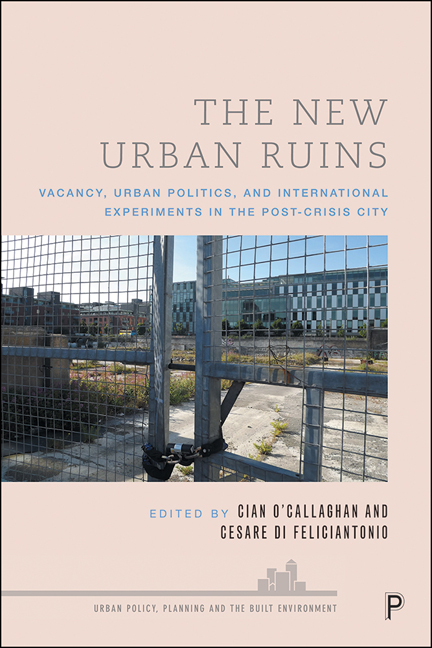Book contents
- Frontmatter
- Contents
- List of figures and tables
- Notes on contributors
- Acknowledgements
- Introduction
- PART I Rethinking ruination in the post-crisis context
- PART II The political economy of urban vacant space
- PART III Reappropriating urban vacant spaces
- Conclusion: Centring vacancy – towards a research agenda
- Index
Introduction
Published online by Cambridge University Press: 13 May 2022
- Frontmatter
- Contents
- List of figures and tables
- Notes on contributors
- Acknowledgements
- Introduction
- PART I Rethinking ruination in the post-crisis context
- PART II The political economy of urban vacant space
- PART III Reappropriating urban vacant spaces
- Conclusion: Centring vacancy – towards a research agenda
- Index
Summary
Empty cities
During the early months of 2020, cities appeared to stop working. The global spread of the COVID-19 pandemic resulted in a wave of nationwide lockdowns as governments mandated restrictions on the movement of populations and the shuttering of all but essential services. Sublime images of familiar cities emptied and at a standstill reached socially distanced audiences via social media. Excepting the ghostly vigil of essential workers – bus drivers, food retail workers and Deliveroo cyclists, as well as medical staff – the pandemic had put our cities on pause.
The empty city became a key representation trope of the pandemic. This is unsurprising given the increasing centrality of urbanisation to contemporary social and economic life. Moreover, as Connolly et al(2020) argue, ‘extended urbanisation’ is itself a key factor in the spread and mitigation of infectious diseases, with interconnected supply chains and deeply unequal urban cores acting as conduits for the spread of COVID-19. However, the pandemic city was one of interconnection, and mobility collapsed. In this way, it bore some relation to the city in ruins: the sense of linear time suspended; the denuded folly of progress visible in streets aggregating windswept litter; and the return of flora and fauna to landscapes usually dominated by humans. If the images were sublime, the experience on the ground was one of the uncanny (Freud, 2003), with familiar urban environments abruptly rendered strange.
The pandemic also signalled urban cavities of different form by exposing the fragility of cities under neoliberalism: underfunded healthcare systems; inadequate and overcrowded housing; and a social apparatus completely dependent on the private sector. A range of cities quickly adopted unprecedented political responses aimed at banning evictions, forgiving delayed rent and mortgage payments, and ensuring access to temporary accommodation through the sourcing of vacant properties. As the pandemic exposed the impact of years of austerity, privatisation and rentier capitalism on cities (Sassen, 2014; Madden and Marcuse, 2016), it also challenged us to rethink our understandings of urban density (McFarlane, 2020) and, by extension, vacancy. While the city during lockdown has the appearance of being empty, it is paradoxically full, with inhabitants confined mostly to private residences.
- Type
- Chapter
- Information
- The New Urban RuinsVacancy, Urban Politics, and International Experiments in the Post-Crisis City, pp. 1 - 18Publisher: Bristol University PressPrint publication year: 2021



